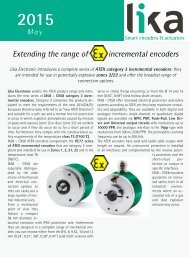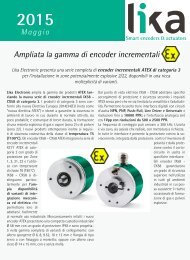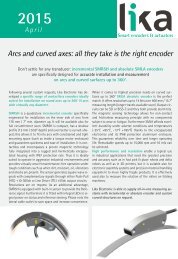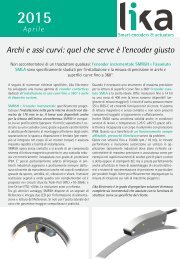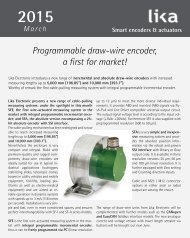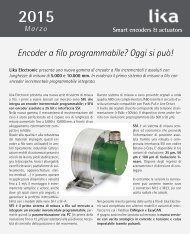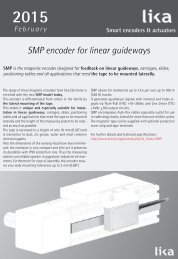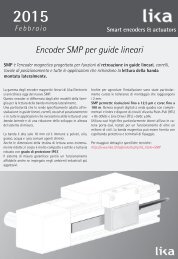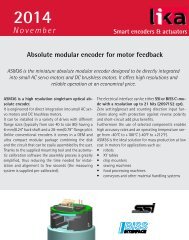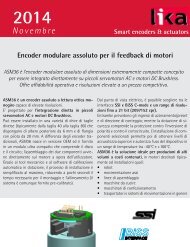LINEPULS & LINECOD catalogue 2016 in English
Lika Electronic incremental and absolute linear encoders catalogue 2016 in English Our new linear encoders catalogue is out now, and features many innovative new products and up-to-date information. The catalogue is expressly designed to set out the comprehensive range of incremental & absolute linear encoders from Lika Electronic. Check it out, it is completely renewed! Make sure you don’t miss out on a copy, download the pdf file from our web site or request your hard copy now! We have also got an interactive digital version in the works that shall be released soon!
Lika Electronic incremental and absolute linear encoders catalogue 2016 in English
Our new linear encoders catalogue is out now, and features many innovative new products and up-to-date information. The catalogue is expressly designed to set out the comprehensive range of incremental & absolute linear encoders from Lika Electronic. Check it out, it is completely renewed!
Make sure you don’t miss out on a copy, download the pdf file from our web site or request your hard copy now!
We have also got an interactive digital version in the works that shall be released soon!
You also want an ePaper? Increase the reach of your titles
YUMPU automatically turns print PDFs into web optimized ePapers that Google loves.
<strong>LINEPULS</strong> • <strong>LINECOD</strong><br />
Technical <strong>in</strong>formation<br />
www.lika.biz<br />
The orientation of the sens<strong>in</strong>g<br />
head over the magnetic tape must<br />
be compulsorily observed and is<br />
always <strong>in</strong>dicated <strong>in</strong> the technical<br />
documentation.<br />
Orientation<br />
Please note that the orientation<br />
does not affect the operation of<br />
an <strong>in</strong>cremental encoder: the encoder<br />
works properly regardless of<br />
the mount<strong>in</strong>g direction of the measur<strong>in</strong>g<br />
system parts.<br />
However check the cable outlet and operate the sensor accord<strong>in</strong>gly to have a standard<br />
count<strong>in</strong>g direction. In an <strong>in</strong>cremental encoder the standard count<strong>in</strong>g direction is achieved<br />
when the sensor moves accord<strong>in</strong>g to the <strong>in</strong>stallation <strong>in</strong>structions so that the ris<strong>in</strong>g<br />
edge of the signal A leads the ris<strong>in</strong>g edge of the signal B; and on the contrary, the reverse<br />
count<strong>in</strong>g direction is achieved when the sensor moves <strong>in</strong> the reverse of the standard direction<br />
so that the ris<strong>in</strong>g edge of the signal B leads the ris<strong>in</strong>g edge of the signal A.<br />
Refer to the specific “User’s guide”.<br />
On the contrary the correct <strong>in</strong>stallation of both the sensor and the tape is mandatory <strong>in</strong><br />
an absolute encoder: the absolute measur<strong>in</strong>g system cannot work if it is not mounted as<br />
<strong>in</strong>dicated <strong>in</strong> the technical documentation.<br />
An arrow pr<strong>in</strong>ted on the upper surface of the absolute tape is <strong>in</strong>tended to help direct the<br />
sens<strong>in</strong>g head properly <strong>in</strong> accordance with the mount<strong>in</strong>g <strong>in</strong>structions: please always check<br />
the cable outlet as well as the direction of the arrow pr<strong>in</strong>ted on the tape.<br />
In an absolute system the arrow further <strong>in</strong>dicates the standard count<strong>in</strong>g direction.<br />
The standard count<strong>in</strong>g direction means that the count <strong>in</strong>creases when the sensor moves<br />
as <strong>in</strong>dicated by the arrow (provided that the sensor is mounted properly). Please always note<br />
down the direction of the arrow on the tape before apply<strong>in</strong>g the cover strip!<br />
For further <strong>in</strong>formation on the standard count<strong>in</strong>g direction please refer to the section “A<br />
and B channels (bi-directional output, s<strong>in</strong>gle ended output)” on page 24 (<strong>in</strong>cremental<br />
encoders) and to the section “Count<strong>in</strong>g direction <strong>in</strong>put” on page 41 (absolute encoders).<br />
To guarantee the encoder reliability over time and a proper work<strong>in</strong>g, the operat<strong>in</strong>g temperature<br />
range <strong>in</strong>dicated under the section “Environmental specifications” <strong>in</strong> the datasheet has<br />
to be fulfilled carefully. When operat<strong>in</strong>g, the encoder can reach the range of temperature<br />
<strong>in</strong>dicated <strong>in</strong> the datasheet. With<strong>in</strong> the stated range of temperature the encoder meets the<br />
performance specifications listed <strong>in</strong> the datasheet.<br />
The m<strong>in</strong>imum and maximum temperature values have been measured <strong>in</strong> compliance with<br />
the standards CEI IEC 68-2-1 and CEI IEC 68-2-2.<br />
Operat<strong>in</strong>g temperature<br />
17




